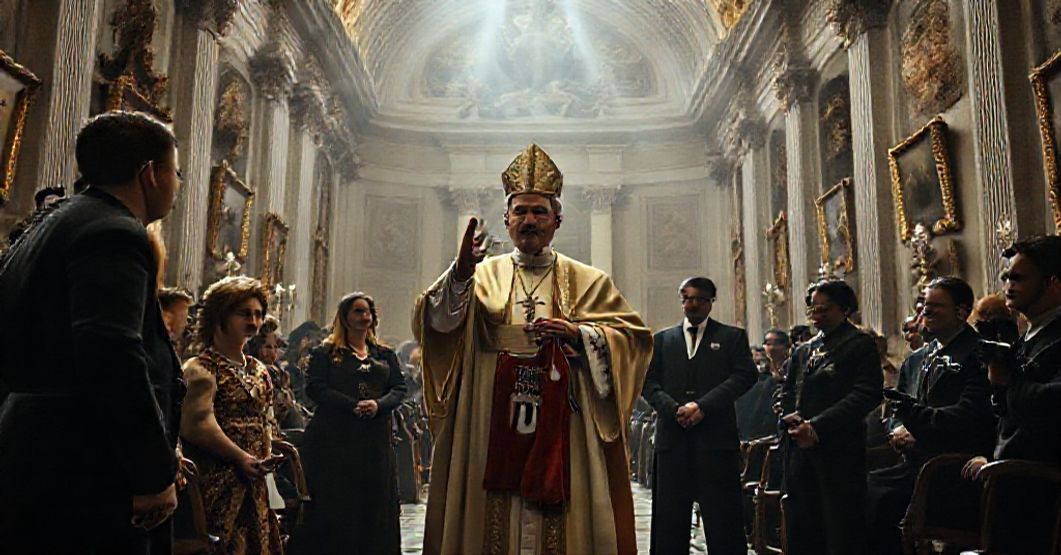Cinema as False Gospel: Antipope Leo XIV’s Syncretism with Worldly Art
The Vatican’s Descent into Cultural Apostasy: A Cinematic Betrayal
VaticanNews portal (November 15, 2025) reports that antipope Leo XIV hosted actors and filmmakers in the Apostolic Palace, declaring cinema an art that “sets hope in motion” and calling for renewed “friendship between the Church and cinema.” The article portrays this gathering as legitimate ecclesial engagement, quoting the usurper’s claims that films help audiences “examine the world as if for the first time” and serve as “workshop[s] of hope.” The event concluded with ceremonial exchanges including actress Cate Blanchett presenting jewelry and filmmaker Spike Lee offering basketball memorabilia.
The Naturalistic Reduction of Supernatural Hope
The conciliar sect’s leader reduces spes in Deo (hope in God) to mere human sentiment when claiming cinema “sets hope in motion.” This constitutes blasphemous substitution of sacramental grace with emotional stimulation. Pius XI’s Quas Primas establishes that true hope flows exclusively from Christ the King’s dominion: “In the Kingdom of our Redeemer… men must prepare themselves through repentance” (§15). The antipope’s message omits any reference to the theological virtue of hope (CCC 1817-1821), instead promoting a naturalistic imitation where films become secular sacraments “accessible to all” regardless of spiritual disposition.
Cinema helps us reflect on the questions deep within our hearts
This statement epitomizes Modernist subjectivism condemned in Pascendi Dominici Gregis: “For the Modernists, both believer and Church begin with the need for the divine… This need is directed toward that phenomenon which they call religion” (§14). By elevating cinematic introspection above catechism and sacraments, the antipope promotes the very vital immanence heresy whereby spiritual truths emerge from human experience rather than divine revelation.
Theaters as New Synagogues of Sentimentalism
When declaring cinemas “the beating hearts of our communities,” Leo XIV inverts the Church’s perennial teaching. Pius IX’s Syllabus of Errors condemns the proposition that “The Church ought to be separated from the State, and the State from the Church” (§55), yet here the conciliar antipope surrenders the social reign of Christ to cultural institutions. The true Cor Ecclesiae (Heart of the Church) is the Eucharistic Sacrifice, not darkened theaters stimulating transient emotions.
The article’s silence regarding moral dangers of cinema exposes diabolical disorientation. Unlike Pius XI who warned against immoral films in Vigilanti Cura (1936), this counterfeit “audience” celebrates filmmakers whose works frequently blaspheme Christian morality (e.g., Spike Lee’s irreverent treatments of redemption narratives). Such omission fulfills St. Pius X’s prophecy in Lamentabili Sane Exitu: “Revelation was merely man’s self-awareness of his relationship to God” (§20).
Sacrilegious Syncretism in Jubilee Disguise
The antipope’s call to make cinema “an art of the Spirit” during the false jubilee constitutes sacrilege. Contrast this with Boniface VIII’s authentic Jubilee indulgence requiring “confession, contrition, sacramental absolution, visits to the four patriarchal basilicas” (Bull Antiquorum Fida, 1300). Instead, these cinema pilgrims undertake a journey “measured in images, words, emotions” – replacing sacramental economy with emotional exhibitionism.
Everyone is important to create the final product
This collectivist mantra ignores the hierarchy of ends established in Leo XIII’s Rerum Novarum: “Civil society exists for the common good, but the end of man is higher than that of his work” (§51). By equating makeup artists with directors, the antipope promotes the Marxist leveling condemned in Pius XI’s Divini Redemptoris while desacralizing artistic hierarchy established by God.
The False Ecumenism of “Beauty and Truth”
Leo XIV’s challenge to bear witness to “beauty and truth” employs deliberately ambiguous language masking apostasy. Pius IX’s Syllabus condemns those claiming “Protestantism is nothing more than another form of the same true Christian religion” (§18), yet the antipope applies identical relativism to cinema. True Catholic beauty flows from adherence to form (St. Thomas Aquinas, ST I.39.8), not subjective artistic expression. The article’s photographs showing attendees in immodest dress further demonstrate the event’s disregard for pudicitia (moral decency).
The acceptance of Blanchett’s bracelet and Lee’s jersey completes this sacrilegious parody. Canon 1399 forbids faithful from receiving sacraments from heretics, yet here antipope and apostates exchange profane gifts mimicking offertory rites. This fulfills St. Pius X’s warning: “The enemies of the Church… turn the help of powers to trying to submit the Church to cruel servitude” (Lamentabili Sane Exitu, closing admonition).
Theological Atrophy of the Conciliar Sect
The VaticanNews article’s complete omission of Christ’s Kingship, the necessity of grace, and the Four Last Things reveals the conciliar sect’s spiritual bankruptcy. Whereas Pius XI instituted Christ the King feast because “the hope of lasting peace will not shine upon nations as long as individuals and states renounce the reign of our Savior” (Quas Primas §1), antipope Leo offers cinema as substitute messiah. This is apostasy fulfilling 2 Thessalonians 2:4 – “the adversary who exalts himself above every so-called god…“
The event’s focus on human collaboration (“communal effort“) rejects the Church’s divine constitution. Pius XII’s Mystici Corporis Christi establishes: “Christ requires His Church’s members to be united because they are all under one Head” (§66). By replacing the Mystical Body with cinematic collectivism, the antipope denies the Church’s supernatural nature – a heresy condemned in Pascendi Dominici Gregis §22.
Conclusion: Cinematic Delusion Versus Eschatological Reality
This sacrilegious spectacle manifests the conciliar sect’s final metamorphosis into purely human institution. As St. Pius X warned: “The Modernists substitute for faith a sentiment grounded in man’s experience” (Pascendi §14). The darkened theater becomes their new sanctuary, emotional manipulation their counterfeit liturgy, and celebrity idols their false priesthood. True Catholics recognize this as abomination foreseen by Our Lady of La Salette: “Rome will lose the faith and become the seat of the Antichrist“.
The only authentic response remains that of St. Paul: “What fellowship has light with darkness?” (2 Cor 6:14). Let faithful Catholics turn from these diabolical spectacles and return to the true Mass – the Unbloody Sacrifice where Christ’s Kingship is manifested, not through screens, but through the Sanctissimum Sacramentum Altaris.
Source:
Pope: Cinema is more than a screen; it sets hope in action (vaticannews.va)
Date: 15.11.2025
